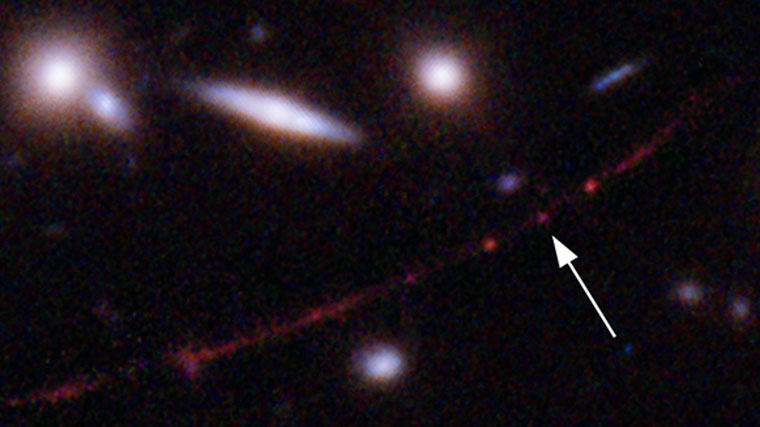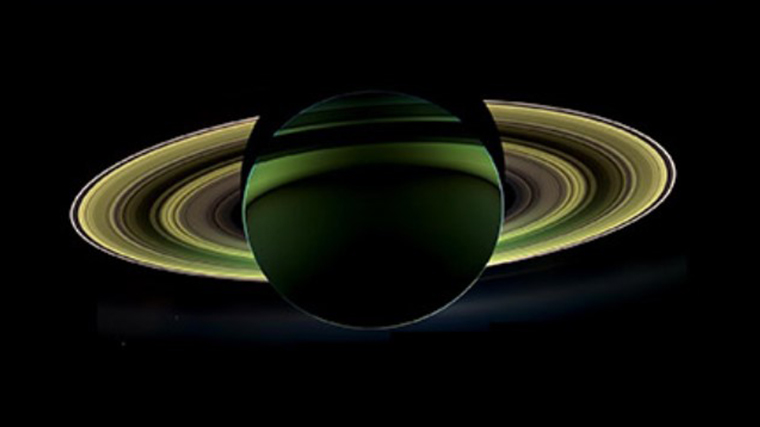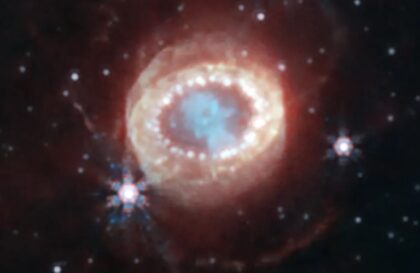“Hubble Palette”
The wide-angle camera, Hubble’s main instrument, is itself black and white, but equipped with a wide magazine of narrow-band filters. Under the name “Hubble palette”, the assembly of a color image from three images at different wavelengths went down in history:
Red channel – two lines of sulfur SII (672 and 673 nm, purplish red).
The green channel is the Hα hydrogen line (657 nm, red), as well as two adjacent and darker NII nitrogen lines.
Blue channel – two oxygen lines OIII (501 and 496 nm, emerald).
Pictures are aligned by brightness, combined, and declared as channels of RGB images. It is in this palette that most of the known color images from Hubble are made.
It is important to understand that the colors are not true colors, and when photographed in true colors (for example, with a camera), the Bubble Nebula will be red.

Transmission to Earth
Information from the Hubble telescope is initially recorded on internal drives. Initially, reel-to-reel tape recorders were used for this purpose, but as part of Expeditions 2 and 3A, they were replaced with more reliable solid-state drives. After that, the data is transmitted via the TDRSS satellite communications system, which is in geostationary orbit, to the Goddard Mission Control Center.
The telescope is in orbit outside the Earth’s atmosphere, which can distort images from ground-based telescopes. The outstanding Hubble mirror weighs over 800 kg. For its manufacture, specially fused quartz glass was used. This material has high strength and resistance to the negative effects of the space environment. The process of grinding and polishing the mirror took almost two and a half years, and although there were some small defects, the result was impressive.
But it was not always so
At the beginning of its mission, the pictures taken by the Hubble telescope turned out to be blurry due to the spherical aberration of the primary mirror. This state has continued since its launch on April 24, 1990. The $1.5 billion project was threatened by this problem, which NASA announced on June 27, 1990. In 1993, engineers developed special corrective optics, or “glasses,” for Hubble that corrected his vision. These optical elements were delivered into orbit and installed. The first observation through the improved Hubble, known as “first light”, occurred on December 18, 1993.
In February 1997, the crew of the shuttle Discovery replaced the telescope’s two spectrographs with more modern models. However, at the end of 1999, just two weeks before the scheduled repair, which was supposed to be carried out using the Discovery shuttle, the fourth of Hubble’s six gyroscopes failed. This failure made it impossible for the telescope to accurately aim at astronomical objects. During the repair work, all six gyroscopes were replaced, and the onboard computer was updated with a more powerful Intel model that is resistant to radiation exposure. This made it possible to perform part of the calculations directly on board the Hubble.
In March 2002, the crew of the space shuttle Columbia replaced the solar panels with more efficient and compact ones, which reduced the effect of atmospheric friction. This modification made it possible to activate all instruments of the Hubble telescope at the same time. For the first time in the history of the mission, the Hubble was completely disconnected from the power supply to carry out the necessary work.
In May 2009, the fifth and final scheduled service mission was completed. During this mission, a significant part of scientific instruments was replaced, thermal insulation was repaired and new batteries were installed.
The restoration of full scientific observations after each service mission usually took several months. It is important to note that all of these repairs were made possible by the original concept of Hubble as a telescope designed to be repairable in space. Each expedition included the work of seven experienced astronauts who spent many hours in outer space. To perform repair tasks, the Hubble was fixed on a special platform in the shuttle’s cargo compartment. It should also be noted that the size of the Hubble can be compared to a four-story house.
Currently, Hubble continues to amaze us with amazing beauty and depth of photographs, continuing its scientific mission.
Highlights in 2022
Hubble’s observations over the years have helped scientists determine the expansion rate of the universe, identify Pluto’s moons, and shed light on exotic worlds.
Even in 2022 alone, Hubble broke records by taking stunning images.
Hubble recently discovered the most distant known star, dubbed Earendel. The images show Earendel as it was 12.9 billion years ago, just 900 million years after the Big Bang:

The telescope continues to capture stunning views, such as this in-depth look at the Terzan 2 globular cluster in Scorpio:

The Hubble Telescope is making a significant contribution to an ongoing project called the Young Star Ultraviolet Heritage Library as Primary References (ULLYSES). This program uses Hubble’s rich data archives, including its unique abilities in the ultraviolet region of the spectrum, to study the processes of star formation.
The telescope also recently took a survey of Comet Bernardinelli-Bernstein (C/2014 UN271), confirming that it is the most massive comet known in the Oort Cloud. New observations have made it possible to determine the diameter of its core, which is estimated at 137 kilometers (85 miles). Projections show that Comet Bernardinelli-Bernstein will reach perihelion, the closest point to the Sun in its orbit, outside the orbit of the planet Saturn in 2031.

JWST can’t replace the Hubble telescope?
The role of the Hubble telescope in the new era of JWST remains unquestioned, even though Webb is often seen as the successor to Hubble. However, these two space observatories are fundamentally different.
Hubble focuses on high-resolution imaging and spectra in the ultraviolet and visible regions of the spectrum, while JWST is optimized for infrared research. Hubble remains the main tool for studying nearby stars and galaxies, as well as for studying accretion processes around supermassive black holes.
Hubble is involved in an important program to detect Cepheid variables in three galaxies to determine their distances. Cepheids are maximally variable at blue wavelengths inaccessible to JWST. In addition, JWST switches slowly between targets, making it less suitable for multiple observations of variable objects such as Cepheids.
In addition, parallel observations are planned with Hubble and other observatories, including JWST. Such observations in multiple wavelength ranges can provide unique data that cannot be studied in the ultraviolet, visible, or infrared bands alone.
For example, the neutron star merger was discovered by the LIGO and Virgo collaborations in 2017.
The fate of Hubble
In September 2022, NASA and SpaceX entered into a Space Agreement to explore the possibility of launching the Crew Dragon mission to service and carry the Hubble to a higher orbit. Such a move could potentially extend the lifetime of the telescope by another 20 years.
Image credit:
https://www.nasa.gov
https://www.constellation-guide.com
https://skyandtelescope.org






